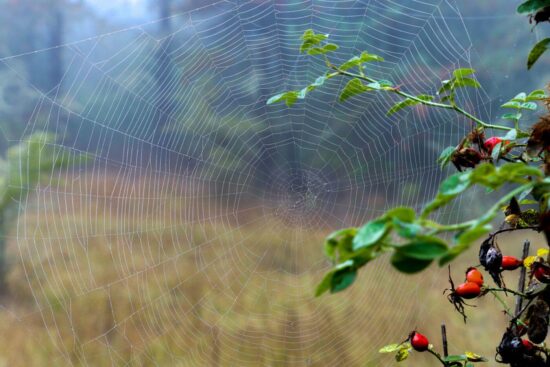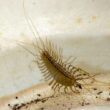Spider webs can make any home look dirty and neglected. These sticky strands collect dust, block air vents, and just plain look gross hanging around your house. Whether you’re dealing with outdoor webs on your siding or indoor cobwebs in corners, learning how to get rid of spider webs properly will keep your home looking fresh and clean.
Getting rid of spider webs isn’t just about looks either. Old webs can trap allergens and dust that affect air quality. Plus, removing webs regularly helps prevent spiders from settling in and making your home their permanent hangout spot.
The good news is that you don’t need expensive chemicals or professional help for most spider web problems. Many effective methods use simple household items you probably already have. From basic cleaning tools to natural sprays, there are plenty of safe ways to tackle this common household annoyance.
1. Use Your Vacuum Cleaner
Your vacuum cleaner is probably the best tool for getting rid of spider webs, especially in high places and tight corners. This method works great because you don’t have to get close to any spiders that might still be hanging around.
What you’ll need:
- Vacuum with hose attachment
- Extension wand or crevice tool
- Step stool or ladder if needed
Start by attaching the hose and extension wand to your vacuum. The long reach helps you get to ceiling corners and other high spots without climbing on furniture. Use the crevice tool for narrow spaces like the gaps between cabinets and walls.
Work from top to bottom so falling debris gets sucked up as you go. Pay special attention to textured ceilings like popcorn styles, where webs love to stick in all the little bumps and grooves. The vacuum’s suction power pulls out even stubborn web pieces that might resist other cleaning methods.
After you’re done, empty the vacuum bag or canister right away. Throw it in an outdoor trash can to make sure any spider eggs or live spiders don’t find their way back into your house. This step is really important because spiders can survive inside vacuum bags for a while.
2. Sweep Them Away with Brooms and Dusters
Sometimes the old-fashioned approach works best. A good broom or long-handled duster can clear away spider webs quickly, especially for routine cleaning.
Best tools for the job:
- Long-handled broom with soft bristles
- Extendable feather duster
- Microfiber dusting wands
The key is using tools with long handles so you can reach high places safely. Many home stores sell extendable dusters that stretch up to 10 feet, perfect for tall ceilings and outdoor eaves.
When sweeping webs, always work in one direction. Going back and forth can actually spread the sticky strands around instead of removing them cleanly. Move slowly and deliberately to avoid flinging web pieces onto nearby surfaces.
For outdoor areas, have a partner hold a dustpan or garbage bag to catch the webs as you sweep them down. This prevents the mess from landing on porches, walkways, or garden areas where you’ll just have to clean them up again later.
3. Try the Duct Tape Trick
This clever method works really well on delicate surfaces where you can’t use water or harsh scrubbing. It’s perfect for textured walls, light fixtures, and anywhere you need gentle but effective web removal.
What you’ll need:
- Roll of duct tape
- Paint roller (clean one)
- Extension pole if needed
Wrap the duct tape around a clean paint roller with the sticky side facing out. You can attach this to an extension pole to reach higher areas safely. Then simply roll the tape over the spider webs. The adhesive grabs onto the web strands and pulls them right off the surface.
This method works especially well on popcorn ceilings and rough stucco walls where other tools might leave pieces behind. The tape gets into all the little crevices and removes every bit of webbing.
Replace the tape when it gets too covered with debris to stick properly. Don’t try to clean and reuse it, just wrap on fresh tape and keep going. When you’re finished, dispose of all the used tape in an outdoor garbage can.
4. Power Wash Outdoor Areas
For heavy outdoor spider web buildup, a pressure washer can save you tons of time and effort. This method is perfect for house siding, deck railings, and other exterior surfaces where webs tend to accumulate.
Safety first:
- Use the lowest pressure setting that still gets the job done
- Spray downward to avoid pushing spiders toward your house
- Keep the nozzle moving to prevent surface damage
Start with a fan nozzle tip rather than a narrow, high-pressure one. The wider spray pattern clears webs effectively without risking damage to paint, wood, or siding materials. Test the pressure on a hidden area first to make sure it won’t cause problems.
If you don’t have a pressure washer, a regular garden hose with a spray nozzle attachment can work for lighter web cleanup. The key is having enough water pressure to break apart the sticky strands and wash them away from your house.
Let everything dry completely after washing. Wet surfaces can encourage mold growth, which creates new problems you definitely don’t want to deal with.
5. Make a Vinegar Cleaning Solution
Vinegar isn’t just great for cleaning windows. It also dissolves spider webs naturally and helps prevent new ones from forming in the same spots. This makes it perfect for how to get rid of spider webs while keeping them from coming back.
Simple recipe:
- Equal parts white vinegar and water
- A few drops of dish soap (optional)
- Spray bottle for easy application
Mix the solution in a spray bottle and shake well. Spray it directly onto spider webs and let it sit for about 10 minutes. The acid in vinegar breaks down the sticky proteins that hold webs together, making them much easier to wipe away.
Use a microfiber cloth or paper towels to clean away the dissolved webs. For outdoor areas, you can just rinse with a garden hose after the vinegar has had time to work.
The great thing about vinegar is that spiders really don’t like the smell. Spraying it around windowsills, door frames, and other entry points helps discourage new web building. Reapply weekly during spider season for the best prevention results.
6. Create Essential Oil Sprays
Essential oils smell wonderful to people but are terrible news for spiders. Getting rid of spider webs with natural oil sprays keeps your home smelling fresh while making it less attractive to eight-legged visitors.
Most effective oils:
- Peppermint (the top choice for spider control)
- Eucalyptus (strong scent that spiders avoid)
- Tea tree (natural antiseptic plus spider deterrent)
- Citrus oils like lemon or orange
Mix 10 to 15 drops of your chosen oil with one cup of water in a spray bottle. Add a small amount of dish soap to help the oil mix better with water. Shake well before each use since oil and water naturally separate.
Spray the mixture on existing webs and around areas where you typically find them. Focus on corners, window frames, light fixtures, and anywhere else spiders like to set up shop. The oils make the webs easier to remove while discouraging new construction projects.
Research shows that peppermint oil is particularly effective at keeping spiders away. The strong menthol scent overwhelms their sensitive smell receptors, encouraging them to find somewhere else to live.
7. Use Soapy Water Solutions
Sometimes the simplest solutions work the best. A basic soap and water mixture can dissolve spider webs quickly and safely, making this approach perfect for indoor use around kids and pets.
Easy recipe:
- 2 cups warm water
- 1 cup liquid dish soap
- Mix in a spray bottle
The soap breaks down the sticky proteins in spider webs, causing them to fall apart on their own. Spray the solution generously on the webs and wait about 15 minutes for it to work. You’ll see the webs start to sag and dissolve as the soap does its job.
Wipe away the dissolved webs with a damp cloth or paper towels. This method also removes any sticky residue that other cleaning approaches might leave behind.
Soapy water works well for both indoor and outdoor web removal. It’s gentle enough for painted surfaces but strong enough to handle even old, dusty cobwebs that have been hanging around for months.
8. Try Bleach for Tough Outdoor Webs
For really stubborn outdoor spider webs, especially on textured surfaces like stucco, a diluted bleach solution can get the job done when other methods fall short.
Important safety notes:
- Always wear rubber gloves and eye protection
- Only use bleach in well-ventilated areas
- Never mix bleach with other cleaning products
Mix equal parts bleach and water in a spray bottle. Apply it to spider webs and egg sacs, then wait 5 to 10 minutes for the bleach to break down the web material. Rinse thoroughly with a garden hose afterward.
This method works especially well on rough, textured exterior walls where webs get really stuck in all the little crevices. The bleach not only removes current webs but also sanitizes the area, which can help prevent quick re-infestation.
Only use this approach outdoors or in areas with excellent ventilation. The strong fumes aren’t safe to breathe in enclosed spaces, and bleach can damage or discolor indoor surfaces.
9. Call Professional Pest Control
Sometimes the spider web problem is too big or too dangerous to handle yourself. Professional pest control services have specialized tools and experience that make getting rid of spider webs much more thorough and effective.
When to consider professional help:
- Webs keep coming back quickly after removal
- You’re finding venomous spiders like black widows or brown recluses
- The infestation covers large areas or hard-to-reach places
- You’re just not comfortable dealing with spiders yourself
Professional services typically cost between $200 and $500 for a one-time visit, depending on your home’s size and the severity of the problem. They’ll identify the spider species, remove all webs and egg sacs, and treat areas to prevent quick return.
Many companies also provide ongoing maintenance programs that include regular web removal and prevention treatments. This can be more cost-effective than repeated one-time visits if you have a persistent spider problem.
The pros have specialized equipment like extension poles with brush attachments that can reach places most homeowners can’t access safely. They also know how to spot and handle dangerous spider species that require extra caution.
10. Use Specialized Web Duster Tools
Professional-quality tools can make spider web removal much easier and more effective. These specialized dusters are designed specifically for cobweb cleanup and can reach places that regular household tools miss.
Professional tools worth considering:
- Extendable web duster brushes
- Telescoping poles with removable brush heads
- Long-handled microfiber dusters
- Commercial cobweb eliminators
These tools typically extend from 6 to 20 feet, letting you reach high outdoor eaves, ceiling fans, and other challenging spots without ladders. The brush heads are designed to grab and hold onto web material instead of just pushing it around.
Many pest control professionals use these tools for routine maintenance between chemical treatments. The brushes work well for dry removal, which you can follow up with liquid cleaners if needed for thorough sanitization.
Look for tools with replaceable or washable heads so you can keep them clean and effective over time. A good web duster can last for years with proper care and makes regular maintenance much less of a chore.
11. Detail Clean with Microfiber Cloths
For final cleanup and detailed work around fixtures and furniture, nothing beats a good microfiber cloth. This approach is perfect for how to get rid of spider webs in delicate areas where other tools might cause damage.
Best techniques:
- Use dry cloths for light, fresh webs
- Dampen slightly with vinegar solution for sticky old webs
- Work in circular motions to grab all the web strands
- Keep multiple cloths handy for different areas
Microfiber’s unique texture grabs onto web material and holds it instead of just moving it around. This makes cleanup much more effective than using regular cotton rags or paper towels.
For detailed work around light switches, outlet covers, and decorative items, the precision control of hand cleaning can’t be beaten. You can work carefully around fragile objects without worrying about damage from sprays or extension tools.
Always wash microfiber cloths immediately after use in hot water. Don’t use fabric softener, as it reduces the cloth’s ability to grab onto dust and debris effectively.
12. Prevent Future Webs with Sealing and Maintenance
The best way to deal with spider webs is to prevent them from forming in the first place. Regular maintenance and sealing entry points keeps spiders from moving in and setting up their sticky decorations.
Key prevention strategies:
- Seal cracks around windows and doors with caulk
- Install weather stripping on doors and windows
- Add fine mesh screens to vents and other openings
- Keep outdoor lighting to a minimum (lights attract spider food)
Create a regular cleaning schedule that includes weekly dusting of corners and monthly deep cleaning of storage areas. Pay special attention to basements, attics, and garages where spiders love to hide.
Remove clutter that provides hiding spots, especially near foundations and entry points. Keep firewood, garden supplies, and storage boxes away from your house’s exterior walls.
Address moisture problems that attract the insects spiders feed on. Fix leaky pipes, improve ventilation in damp areas, and eliminate standing water around your property.
Getting rid of spider webs regularly becomes much easier when you make it part of your routine home maintenance. A little prevention goes a long way toward keeping your home looking clean and web-free year-round.


